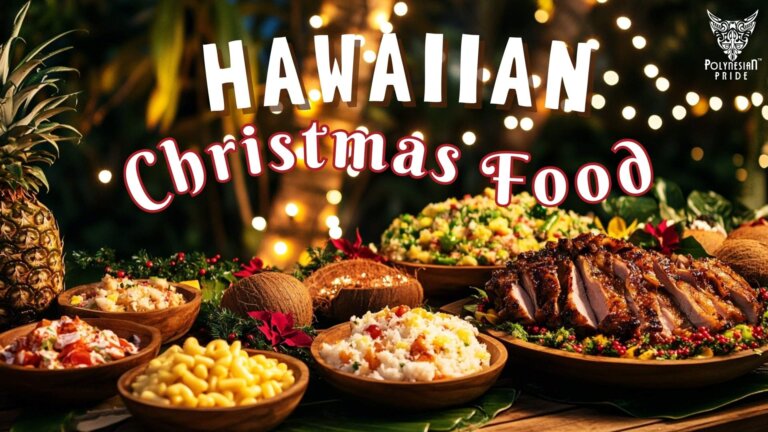American Samoa Food: A Rich Culinary Heritage in Oceania

INTRODUCTION
American Samoa food uniquely blends traditional Polynesian flavors and modern influences. This Pacific island paradise offers a culinary experience that is both diverse and delicious. A culinary journey through American Samoa is a sensory delight, blending fresh tropical ingredients with cooking traditions passed down through generations.
From the fragrant aromas of traditional dishes to the vibrant flavors of modern innovations, the islands’ cuisine offers a unique glimpse into the soul of its people.
I. The Roots of American Samoa Food
Staple Ingredients
American Samoa food is deeply rooted in Polynesian traditions, reflecting the island’s rich cultural heritage. The foundation of this cuisine lies in the use of locally available ingredients and traditional cooking methods that have been perfected over centuries.
The core elements of American Samoan cuisine include:
- Taro: A starchy root vegetable that serves as a staple in many dishes.
- Coconut: Used in various forms, from fresh meat to cream and oil.
- Seafood: An abundance of fish and shellfish from the surrounding Pacific Ocean.
- Tropical fruits: Breadfruit, bananas, and papayas are prominently featured in many recipes.
These ingredients form the basis of numerous traditional dishes, each with its unique flavors and preparation methods.

The ‘Umu’ Technique in American Samoa Food
The umu, or earth oven, is a cornerstone of traditional Samoan cooking. This ancient method involves cooking food underground using heated stones, imparting a unique smoky flavor to dishes.
Key aspects of umu cooking:
- Preparation of the oven by heating volcanic stones.
- Wrapping food in banana or breadfruit leaves.
- Layering food and hot stones in the umu pit.
- Covering the umu with more leaves and soil to trap heat.
The umu is a cooking method and a social event, bringing families and communities together in the food preparation process.

The Role of Coconut in American Samoa Food
Coconut is a versatile and essential ingredient in American Samoan cooking. Every part of the coconut is utilized, from its water and meat to its husk and shell.
Uses of coconut in Samoan cuisine:
- Coconut cream: A base for many sauces and stews.
- Coconut water: A refreshing drink and cooking liquid.
- Coconut meat: Used fresh or dried in various dishes.
- Coconut oil: For cooking and flavoring.
The abundance of coconuts on the islands has made it an integral part of both traditional and modern Samoan dishes.
Seasonal Ingredients in American Samoa Food
American Samoa’s tropical climate allows for a year-round growing season, but certain ingredients are more abundant at different times of the year. This seasonality influences the types of dishes prepared and consumed.
Examples of seasonal ingredients and their uses:
- Breadfruit (ulu): It is available in abundance from July to December and is used in both savory and sweet dishes.
- Mangoes: Peak season from December to April, eaten fresh or used in desserts and preserves.
- Taro: Harvested year-round but more plentiful during the rainy season, a staple in many traditional dishes.
Understanding the seasonal availability of ingredients provides insight into the rhythm of American Samoa cuisine and its connection to the natural environment.

II. The Evolution of American Samoa Food
Ancient Polynesian Culinary Traditions
The culinary heritage of American Samoa can be traced back to ancient Polynesian traditions. These early settlers brought with them a wealth of knowledge about local plants, fishing techniques, and cooking methods that formed the foundation of Samoan cuisine.
Key aspects of ancient Polynesian culinary traditions include:
- Earth oven cooking (umu): A method of cooking food underground using heated stones.
- Fermentation techniques: Used to preserve foods and create unique flavors.
- Coconut: can be used in various forms, such as a source of liquid, oil, and meat.
- Staple crops: Taro, breadfruit, and yams.
These traditional practices continue to influence modern American Samoan food, preserving a connection to the island’s ancient past.

The Impact of European Contact
The arrival of European explorers and missionaries in the 18th and 19th centuries brought new ingredients and cooking methods to American Samoa. This period of contact introduced:
- New fruits and vegetables: Pineapples, citrus fruits, and tomatoes.
- Livestock: Cattle, pigs, and chickens became more prevalent.
- Cooking utensils: Metal pots and pans supplemented traditional cooking tools.
- Baking techniques: The introduction of baking techniques includes bread-making and the preparation of other baked goods.
These additions expanded American Samoa’s culinary repertoire, blending with existing traditions to create new flavors and dishes.
The American Era and Modern Influences
Since becoming a U.S. territory in 1900, American Samoa has experienced significant changes in its food culture. The American influence has brought:
- Fast Food Chains: The introduction of fast food chains brought American-style burgers, fries, and soft drinks.
- Modern Appliances: The adoption of modern appliances includes refrigeration, gas stoves, and microwaves.
- Globalization: Access to a wider variety of international ingredients and cuisines.
This cultural exchange has led to the integration of new ingredients, cooking techniques, and flavors into the local cuisine, including:
- Grilling and Barbecue Techniques: American-style grilling has gained popularity.
- American-Style Desserts and Baked Goods: These have found their way into American Samoan kitchens.
While these changes have brought convenience and variety, they have also led to concerns about the loss of traditional food knowledge and the rise of diet-related health issues in American Samoa.

III. The Cultural Significance of American Samoa Food
American Samoan Cuisine’s Role
In American Samoa, food is more than just sustenance; it plays a central role in social and cultural life. Meals are often communal affairs, bringing families and communities together to share not just food but stories, traditions, and values.
Key aspects of American Samoa food culture include:
- Hospitality: Offering food to guests is a fundamental expression of American Samoan hospitality.
- Ceremonies: Traditional foods play crucial roles in various cultural and religious ceremonies.
- Social bonding: Communal preparation and consumption of meals strengthen social ties.
- Cultural identity: Traditional dishes serve as a link to American Samoan heritage and identity.
Understanding the cultural context of American Samoa food is essential to fully appreciating the depth and richness of its cuisine.
The Cultural Importance of Food Sharing
In American Samoan culture, the act of sharing food goes beyond mere sustenance; it is a fundamental expression of hospitality, respect, and community bonding.
Key aspects of food sharing in American Samoan culture:
- To’ona’i: Sunday lunch gatherings after church services.
- Fa’alavelave: Contributions of food for important life events.
- Ava ceremony: Ritualized sharing of kava drink in formal settings.
These practices reinforce social ties and cultural values, highlighting the central role of food in Samoan society.

IV. The Must-try Of American Samoa Food
Palusami: The Heart of American Samoan Cuisine
Palusami is the most iconic food in American Samoa. This savory delight consists of young taro leaves filled with coconut cream and sometimes meat, wrapped in breadfruit leaves, and cooked in an umu (earth oven).
Key features of palusami:
- Rich, creamy texture.
- The umu cooking process imparts a subtly smoky flavor to the food.
- Versatility in fillings (can include chicken, beef, or fish).

Oka I’a: A Refreshing Raw Fish Delicacy
Oka, also known as ota in Samoan, is a popular dish of raw fish marinated in citrus juice and coconut cream. This refreshing appetizer showcases the islands’ abundant seafood and tropical flavors.
Components of a typical oka dish:
- Fresh fish (often tuna or snapper).
- Lime or lemon juice.
- Coconut cream.
- Diced onions, tomatoes, and cucumbers.
- Salt and pepper to taste.

Fa’ausi: The Sweet Side of Samoan Cuisine
Fa’ausi is an American Samoa famous food showcasing the islands’ love for sweet treats. This dish consists of small pieces of baked taro or breadfruit covered in a lovely coconut caramel sauce.
Preparation of fa’ausi involves:
- Baking or frying taro or breadfruit until crispy.
- Preparing a thick syrup from coconut cream and brown sugar.
- Pouring the warm syrup over the crispy taro or breadfruit pieces.

Other Delightful American Food
Sapasui: is a hearty noodle dish stir-fried with vegetables and your choice of beef or chicken, seasoned with island spices, for a satisfying meal.
Faiai eleni: Consists of corned beef, onions, and sometimes cabbage or other vegetables, all cooked together in a savory and hearty preparation. It’s often enjoyed with rice or taro and is known for its comforting flavors that are beloved by locals and visitors alike.
Supoesi (Papaya Soup): A cherished American Samoan dish made from ripe papayas and coconut milk, celebrated for its nutritional benefits and delicious flavor. Traditionally served with Samoan breads like panipeke or panipopo.
Kopai: American Samoa’s unique take on dumpling soup, offering a sweet twist that stands out from typical meat or veggie-filled dumplings. Kopai features dense, doughy dumplings called puka, soaked in a rich, gooey sauce made from coconut cream and brown sugar.

V. Preserving The Culinary Heritage of American Samoa Food
Maintaining Traditional Cooking Techniques
Despite the influx of modern conveniences and international influences, there is a growing movement in American Samoa to preserve traditional cooking techniques and recipes.
Efforts to preserve traditional cuisine include:
- Cultural festivals: Showcasing traditional foods and cooking methods.
- Educational programs: Teaching younger generations about traditional food preparation.
- Community initiatives: Promoting the use of local, sustainable ingredients.
By valuing and maintaining their culinary heritage, American Samoans ensure that future generations can continue to enjoy and appreciate the flavors of their ancestors.
Modern Savor in American Samoa Food
In recent years, American Samoa has seen the rise of fusion cuisine, blending traditional Samoan flavors with international influences. This culinary evolution reflects the islands’ dynamic and diverse culture.
Examples of fusion dishes in American Samoa:
- Samoan-style sushi: Incorporating local seafood and tropical ingredients.
- Coconut curry: Blending Indian spices with traditional Samoan ingredients.
- Poke bowls: Featuring fresh fish with Samoan-style marinades and toppings.
Fusion cuisine offers a contemporary twist on traditional flavors, creating exciting new dining experiences for locals and visitors alike.

CONCLUSION
American Samoa’s culinary landscape is a rich and diverse tapestry that reflects its unique blend of Polynesian heritage and American influence. From the ancient traditions of umu cooking and the significance of coconut in everyday meals to the modern innovations of fusion cuisine, the islands’ food culture is a testament to the resilience and creativity of its people. By exploring and celebrating these culinary traditions, we not only savor the flavors of American Samoa food but also gain a deeper understanding of its vibrant cultural identity.
FAQs
What are popular foods in American Samoa?
American Samoa food boasts a rich culinary heritage. Some traditional dishes include palusami, which consists of young taro leaves wrapped around coconut cream and onions, baked in an umu (earth oven). Oka is another favorite, featuring raw fish marinated in lemon juice and mixed with coconut milk, onions, and sometimes cucumber or tomatoes.
Are there any popular American Samoa food festivals?
The Teuila Festival is a significant event that showcases traditional dance performances and cultural demonstrations, and it allows visitors to sample local cuisine. It’s a vibrant celebration that highlights Samoan culture and heritage.
How has American culture influenced American Samoa food?
Since becoming a U.S. territory, American Samoa food has seen the introduction of processed foods, fast food chains, and modern cooking appliances. These influences have added variety to the local cuisine but also raised concerns about dietary health.
What is the national food of American Samoa?
The national food of American Samoa is palusami. It consists of taro leaves filled with coconut cream and cooked to create a rich and flavorful dish that is beloved throughout the islands.

I am a cultural historian and editor with over 10 years of research into pre-contact Polynesian history, the Lapita migration, and oral traditions. Share the excitement of my latest publications.
My contact:
Email: [email protected]
Tel: +64 21 456 7890






